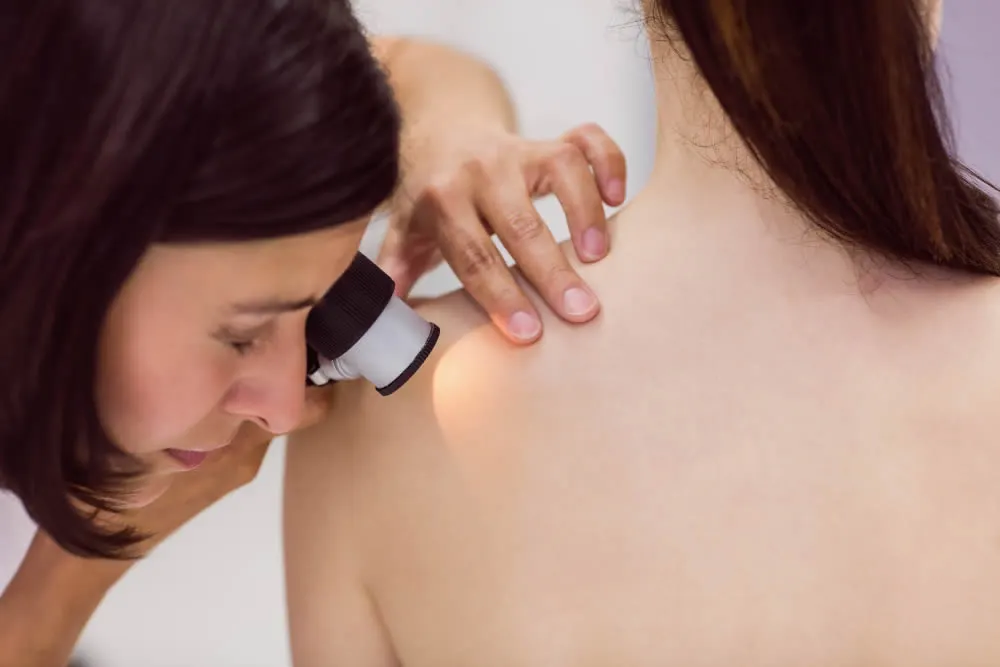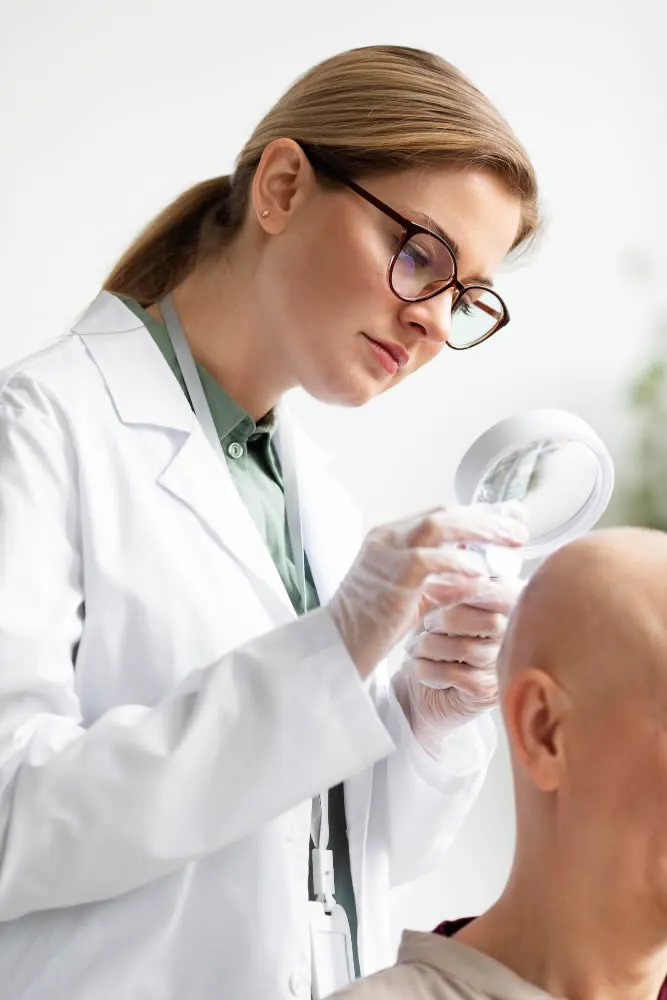Squamous Cell Carcinoma
What is Squamous Cell Carcinoma?
Squamous cell carcinoma is a common skin cancer starting in squamous cells, making up the skin’s middle and outer layers. Usually not life-threatening, it can grow large if untreated, leading to serious complications. Most cases stem from ultraviolet (UV) radiation from sunlight or tanning devices.
Those who sunburn easily may find it in sun-exposed areas, while in people with Black and brown skin, it might appear in less exposed spots. Protection from UV light, such as sunscreen, can reduce the risk, highlighting the importance of vigilant skin care.

What are the symptoms of Squamous Cell Carcinoma?
Squamous cell carcinoma of the skin can manifest in various ways, often appearing on sun-exposed areas like the scalp, ears, or lips. However, it can occur anywhere, even inside the mouth or on the genitals.
The symptoms are noticeable and can include:
- A firm bump, or nodule, that may match your skin color or appear pink, red, black, or brown.
- A flat sore with a scaly crust that’s hard to ignore.
- A new or raised area on an existing scar or sore, adding a twist to an old mark.
- A rough patch on the lip that may turn into an open sore a warning sign you don’t want to miss.
- A sore or rough area inside the mouth, a hidden but telltale sign.
- A raised or wartlike sore on or in the anus or genitals, an unpleasant surprise.
These symptoms signal the body’s cry for attention, and it’s vital not to ignore them. If you notice any of these signs, consult a dermatologist.
What are the causes of Squamous Cell Carcinoma?
The root of squamous cell carcinoma lies in changes to the DNA within squamous cells, those skin cells with a crucial role. DNA is like a cellular instruction manual, dictating actions. Alterations prompt these cells to multiply swiftly, defying their natural lifecycle by surviving when they should perish.
This reckless growth leads to an excess of cells, which in turn can invade and wreak havoc on healthy tissue. Over time, these cells can detach, spreading their mischief to other corners of the body.
UV radiation takes the blame for most DNA alterations. Whether it’s sunlight, tanning beds, or those tanning lamps, UV radiation is the culprit. However, here’s an unexpected twist: skin cancers can sprout in areas not often exposed to sunlight. This suggests that other factors might join forces, increasing the risk. One such factor is having an immune system weakened by a specific condition.
How to diagnose Squamous Cell Carcinoma?
Squamous cell carcinoma has its roots in a mutation of the p53 gene. This gene is like the conductor of the cell division orchestra, instructing cells on when and how to replicate, replenishing themselves as needed. It’s a tumor suppressor, ensuring cell growth remains in check. However, this gene can go awry due to ultraviolet (UV) exposure from sunlight or indoor tanning beds.
When the p53 gene mutates, the cellular instructions get muddled. This miscommunication leads squamous cells to divide and reproduce excessively, birthing tumors—those unwelcome bumps, lumps, or lesions—in various nooks and crannies of the body. Think of it as a symphony conductor suddenly playing the wrong notes, leading to a discordant melody of cell growth and multiplication.
How to treat Squamous Cell Carcinoma?
When tackling squamous cell carcinoma, the goal is clear: remove the cancer from your body. Your treatment options hinge on factors like the cancer’s size, shape, and location.
Here’s a lineup of potential approaches:
- Cryosurgery: Like freezing a pesky intruder, this method uses cold to destroy cancer cells.
- Photodynamic therapy (PDT) is a light show for cancer cells. Blue light and light-sensitive agents team up to kick out unwanted guests.
- Curettage and electrodesiccation: It’s like a double whammy. First, the cancerous lump gets scraped off with a spoon-like tool (curette). Then, an electric needle brings the heat, sealing the deal.
- Excision: Time to cut it out. The cancer gets snipped from your skin, and then your skin gets stitched back together.
- Mohs surgery: It’s all about precision. Layers of cancer-affected skin are peeled away, a technique often used for facial cancers.
- Systemic chemotherapy: Heavy-duty medicines obliterate cancer cells across your body.
When it comes to medications, they’re not to be underestimated:
- Skin creams with imiquimod or 5-fluorouracil work their magic on squamous cell carcinoma lounging in the top layer of your skin, giving them a proper eviction notice.
- Cemiplimab-rwlc (Libtayo®): This immunotherapy superhero targets advanced forms of squamous cell carcinoma.
- Pembrolizumab (Keytruda®): Another immunotherapy champion, tackling squamous cell carcinoma that surgery can’t handle.

FAQ About Squamous Cell Carcinoma
What are the side effects of the treatments for Squamous Cell Carcinoma?
The most common side effect of squamous cell carcinoma treatment is cosmetic changes to your skin, like scarring, after your healthcare provider removes the cancer from your body. If you take immunotherapy drugs to treat your cancer, talk to your healthcare provider about the side effects of the drugs.
How soon after treatment will I feel better?
The amount of time your body needs to heal after treatment varies for each person. The size, shape, and location also affect your healing time after treatment. On average, most people will recover within two to four weeks after treatment to remove cancer from their body.
What can I expect if I have Squamous Cell Carcinoma?
Most cases of squamous cell carcinoma have a positive prognosis and an excellent survival rate if you receive an early diagnosis. Early detection and treatment prevent the tumor from growing and damaging other parts of your body. If your healthcare provider removes your cancer, there’s a chance it can return in the future. Make sure to follow up with your healthcare provider to verify you’re cancer-free. It’s also important to protect your skin from UV rays when outdoors.
What is Squamous Cell Carcinoma in situ?
Squamous cell carcinoma in situ is also known as Bowen disease. The term “in situ” means that the cancer cells are only in the top layer of your skin (epidermis). The most common places to find Bowen disease is on sun-exposed areas of your skin, but the condition can also appear on the skin near your anal cavity and genitals, like on your labia or vulva (vulvar cancer).
Is there a dermatologist near me in Anaheim that offers treatment for Squamous Cell Carcinoma?
Yes. At our Anaheim dermatology office we offer treatment for Squamous Cell Carcinoma to patients from Anaheim and the surrounding area. Contact our office today to schedule an appointment.
